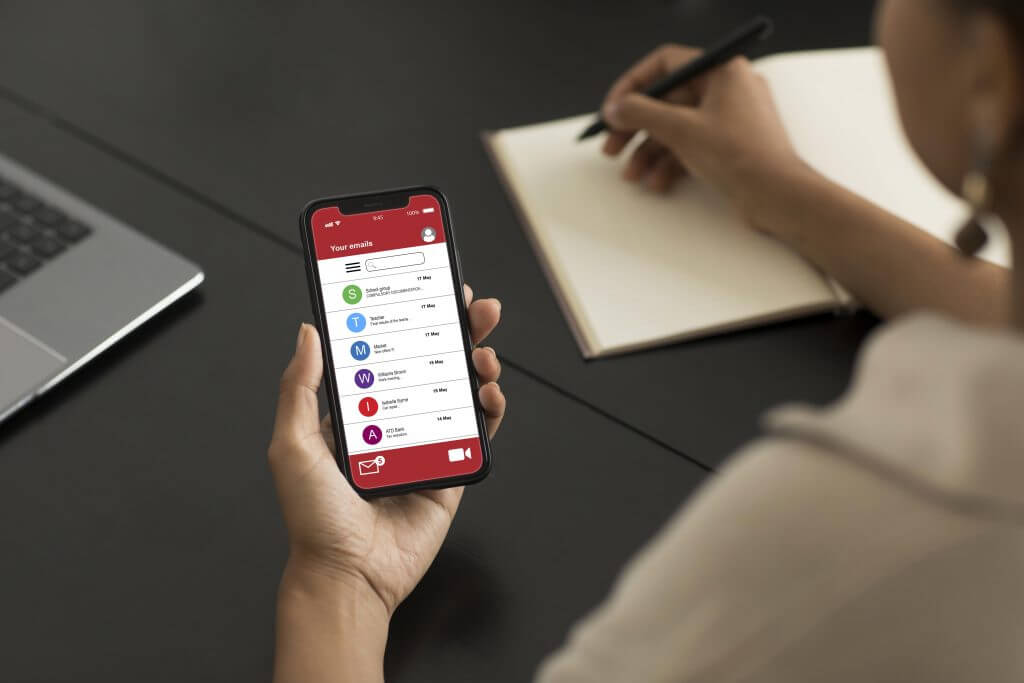Utilizing email marketing has always been a potent method to propel your business forward. Its adaptability across various industries and demographics, coupled with its track record of driving engagement and conversions, makes it a cornerstone of marketing strategies.
But how does email marketing fare specifically for mobile applications? And what strategies can you employ to craft impactful and successful campaigns?
In this article, we’ll explore the efficacy of email marketing for apps and provide guidance on how to harness its potential to boost awareness and drive downloads.
CONTENTS
The Significance of Email Marketing for Mobile Apps
Preparation Before Launching Your Mobile App Email Campaign
Formulating a Robust Email Marketing Strategy for Your Mobile App
The Significance of Email Marketing for Mobile Apps

Email marketing has perennially been a vital asset in the marketer’s toolkit.
- Fundamentally, email marketing facilitates businesses of all sizes in reaching new audiences, bolstering customer retention, and fostering brand recognition. Notably, its direct approach to reaching consumers stands out as a key advantage.
This direct line of communication fosters a mutually beneficial relationship with recipients. Subscribers to email lists receive pertinent updates and information, often related to products or services they already have an interest in.
This existing affinity makes email marketing particularly effective for app promotion. When users receive an email regarding your app, they are more inclined to engage, given its endorsement from a trusted source.
The Advantages of Email Marketing for Mobile Apps
Let’s delve deeper into the benefits that email marketing offers for promoting mobile apps:
- Precise Audience Targeting: Email enables meticulous targeting, ensuring that your app’s promotional endeavors reach an audience already expressing interest in your content, circumventing the challenges posed by social media algorithms.
- Personalization and Segmentation: Email marketing excels in its capacity for tailoring messages. This proves invaluable for apps, as you can address distinct segments of your audience—whether new, active, or dormant users—with customized communication.
- Cost-Efficiency: Particularly advantageous for app proprietors operating within budget constraints, email marketing presents numerous cost-effective tools for reaching a sizable audience without the hefty expenses associated with alternative marketing channels.
- Trackable Results: Email campaigns offer measurable outcomes through metrics like open rates, click-through rates, and conversion rates. These insights serve as invaluable guides for refining app marketing strategies.
- User Re-engagement: Email serves as an effective conduit for rekindling the interest of users who have previously downloaded the app but haven’t engaged with it lately. Through updates, feature announcements, or special incentives, you can reignite their enthusiasm.
- Establishing Thought Leadership & Enhancing Brand Visibility: Establishing your app as a frontrunner in its category is paramount for maintaining a competitive edge. Alongside contending with rival apps, you face competition from analogous services. Email marketing emerges as a potent strategy for showcasing expertise and captivating users with valuable insights, aiding them in addressing challenges your app resolves or offering meaningful benefits.
Preparation Before Launching Your Mobile App Email Campaign
Before embarking on crafting your email marketing campaign for your mobile app, it’s imperative to undertake two essential preparatory steps: defining your objectives and identifying your target audience.
Devoid of clear objectives and targets, how do you gauge success? How will success be quantified? Ahead of dispatching any campaigns, meticulous deliberation regarding your email strategy is indispensable.
- Each email dispatched should harbor a distinct objective.
For instance, your initial email might serve to introduce recipients to the app and entice them to download it. Subsequent emails could focus on fostering user engagement by spotlighting key features or extending exclusive promotions. Further emails may concentrate on user retention, soliciting feedback, or unveiling updates.
- By delineating precise objectives for each email, you fashion a structured and purpose-driven mobile app marketing campaign that shepherds users through diverse stages of their app journey.
Equally pivotal is identifying your target audience. Comprehending their predilections, behaviors, and pain points equips you to tailor your emails adeptly.
- Whether catering to nascent users or nurturing existing ones, aligning your content with the audience’s exigencies and interests is paramount.
This strategic approach augments the overall efficacy of your email marketing endeavor, heightening the likelihood of realizing your desired outcomes.
Crafting an Effective Email Marketing Blueprint for Your Mobile App
Once you’ve identified your target audience and established initial objectives, the next step is to formulate a comprehensive email marketing plan for your mobile application. Let’s dive into the process.
First Step: Choose an Email Marketing Provider
Fortunately, there’s no shortage of email marketing solutions designed to enhance app awareness. The key is selecting one that aligns with your requirements and is user-friendly. Consider features such as:
- Advanced audience segmentation
- Quality customer support
- Enhanced security measures
- Automation capabilities
- User-friendly interface
Whether your focus is on B2B or B2C, Digfinity’s email marketing service offers a holistic solution to amplify your email marketing endeavors, covering everything from conceptualization and design to content creation, automation, and mobile app optimization.
Build Your Email Subscriber Base

Establishing a targeted email list before app launch is essential to ensure your crucial announcements and updates reach the right audience. For existing apps, refine and optimize your email list based on user feedback and engagement.
- Start by collecting email addresses and contact details through a newsletter signup form on your website. Platforms like WordPress and Squarespace offer user-friendly widgets or templates for seamless email address collection.
Upon visiting your website, visitors encountering a pop-up urging them to “Subscribe to our newsletter” are more inclined to provide their contact information. Ensure the pop-up includes a clear call-to-action, a compelling headline, and necessary form fields for easy data entry.
Consider offering incentives for sign-ups, such as discounts upon app download or in-app perks.
Focus on Email Design & Layout
Effective email design plays a crucial role in capturing recipients’ attention and driving engagement.
- Invest time and effort in aligning your email design with your brand persona. Consistency across marketing channels fosters trust, underscores professionalism, and reinforces your marketing message.
Choose from various email design platforms (including free options like Canva) or engage expert email marketing design services. Incorporate the following elements into your email design:
- Engaging email copy: Ensure your emails reflect your brand’s tone to maintain consistency and resonance with your target audience. Keep the messaging clear and concise to facilitate engagement with your call-to-action.
- Visually appealing imagery: Incorporate relevant visuals, such as screenshots or preview videos, to provide instant visual cues. For instance, a fitness app promotion could feature images of users exercising or enjoying post-workout refreshments.
- Prominent call-to-action: Clearly guide recipients on the desired action, whether it’s subscribing to your newsletter or downloading your app.
- Unsubscribe option: Including an unsubscribe link is both a legal requirement and a best practice for respecting recipients’ preferences. Ensure GDPR compliance, particularly when targeting European audiences.
Consistency in font choices, image selection, and overall branding is paramount for impactful email design.
Incorporate App Links
Upon app launch, provide recipients with easy access to download links or additional information.
- A launch campaign involves emailing your subscriber list to announce your app’s availability and encourage downloads, possibly accompanied by incentives like discounts or special offers.
Include download links and app interlinks in all communication channels, including newsletters, website pop-ups, social media, and printed materials like QR codes.
Monitor Campaign Performance
Analyzing campaign metrics is essential for assessing effectiveness and refining strategies.
- Track metrics such as open rates, conversions, click-through rates, and bounce rates to gain insights into audience preferences and campaign efficacy. A/B testing can help identify optimal campaign elements for improved conversion rates.
Experiment with subject lines, email content, and CTAs to understand user preferences and refine campaigns accordingly.
Formulating a Robust Email Marketing Strategy for Your Mobile App
Email marketing serves as a potent tool for promoting your app, enabling direct communication with customers and expanding your app’s reach.
By implementing the strategies outlined above and leveraging expert email marketing services, you can bolster app awareness, drive engagement and downloads, and keep your audience informed about app updates.
Continuously evaluate campaign performance and adapt strategies as needed to optimize results and align with evolving audience preferences.
Assessing Your Campaign’s Performance
Evaluating the effectiveness of your campaign is essential for understanding what resonated with your audience and what didn’t. This insight allows you to refine future campaigns based on data gleaned from audience feedback and analytics tools.
Examining key metrics such as open rates, conversions, click-through rates, bounce rates, and engagement levels provides valuable insights into audience preferences and behaviors. Utilizing A/B testing enables you to gauge the effectiveness of different campaign elements and optimize for improved conversion rates.
Experimentation with subject lines, email content, and calls-to-action helps uncover user preferences, enabling you to tailor future campaigns to better meet the needs and expectations of your audience.
Conclusion
Email marketing remains a potent tool for elevating your app’s visibility and engagement. Its direct communication with customers enables you to reach a broader audience and maintain a direct line of contact with your users.
By implementing the strategies outlined above and leveraging the expertise of professional email marketing services, you can effectively enhance awareness around your app, drive increased engagement and downloads, and keep your audience informed about relevant updates.
Remember, the key to success lies in formulating a comprehensive mobile marketing strategy from the outset and continuously monitoring its performance. Be open to adapting and refining your approach based on campaign results to ensure continued success.
FAQS :
Q1. What is email marketing, and why is it important for app promotion?
A1. Email marketing involves sending targeted messages via email to potential or existing customers to promote products or services. It’s crucial for app promotion because it allows direct communication with users, increasing awareness and driving downloads.
Q2. How can email marketing benefit app developers?
A2. Email marketing enables app developers to reach their target audience directly, personalize messages, track campaign performance, re-engage inactive users, and establish thought leadership, ultimately driving app downloads and user engagement.
Q3. What are some best practices for creating effective app promotion emails?
A3. Best practices include segmenting the audience, personalizing messages, crafting compelling subject lines and email content, optimizing email design for mobile devices, including clear calls-to-action, and monitoring and analyzing campaign performance for continuous improvement.
Q4. How can app developers build and grow their email subscriber list?
A4. App developers can build their email subscriber list by implementing newsletter signup forms on their website, offering incentives for subscription, leveraging social media and other marketing channels to promote newsletter signups, and providing valuable content to encourage user engagement.
Q5. What metrics should app developers track to measure the success of their email marketing campaigns?
A5. Key metrics to track include open rates, click-through rates, conversion rates, bounce rates, unsubscribe rates, and engagement metrics such as time spent on app and in-app actions triggered as a result of email campaigns. Tracking these metrics helps app developers assess campaign effectiveness and optimize future efforts.



